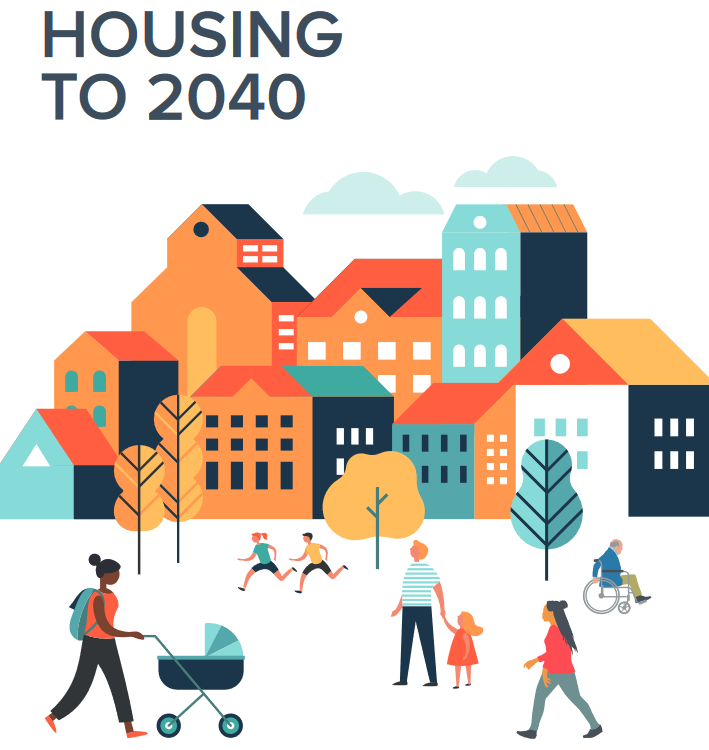Housing to 2040 strategy launched with plan for 100,000 more affordable homes
Plans to deliver 100,000 affordable homes over the next decade are set out today in a document that outlines Scotland’s first long-term housing strategy.

Recognising the importance of everyone having a safe and affordable home that meets their needs, Housing to 2040, as well as the document’s vison and principles, outline what the Scottish Government wants housing and communities to look and feel like for the people of Scotland, with actions on how to get there.
Around £16 billion will be invested to deliver 100,000 more affordable homes by 2032, with at least 70% of these being for social rent. The target will support up to 14,000 jobs a year, according to the document.
Plans for a new legal requirement for all homes to meet the same standards are also included in the strategy. Applying to all tenures, the new Housing Standard will create a single set of quality and accessibility standards.
Following consultation, and subject to the outcome of the election, the Scottish Government will publish a draft Standard in 2023 and introduce legislation in 2024-25, for phased introduction between 2025 and 2030, recognising that different types of homes in different places may need more or less time to achieve compliance.
Other key priorities in the strategy, which will be taken forward subject to the outcome of the election, include:
- tackling high rents in the private sector and supporting fair, accessible private and social rental sectors through a Rented Sector Strategy and Housing Bill
- decarbonising heating in all homes in line with Scotland’s climate ambitions, ensuring this is done in a fair and just way, including by adapting and retrofitting existing homes
- aiming for all new homes delivered by Registered Social Landlords and local authorities to be zero emissions by 2026
- establishing a new fund to help local authorities bring empty homes back into residential use
- supporting housing development in rural and island areas, helping to prevent depopulation and enabling communities to thrive
- continuing with our updated plan to end homelessness and rough sleeping once and for all
- undertaking a comprehensive audit of our current housing and homelessness legislation to understand how best to realise the right to adequate housing.
Communities secretary Aileen Campbell said: “Homes are not simply bricks and mortar. They support people’s health, wellbeing and life chances, can help to tackle poverty and climate change, and are a major investment in the economy. Housing policy is essential in helping us achieve our ambitions for a fairer, more equal Scotland.
“Housing to 2040 sets out a vision for what we want homes and communities to look and feel like for people regardless of their stage in life or where they live. It is a vision where homes are affordable for everyone, where standards are the same across all tenures, where homes have easy access to green space and essential services, and where homelessness, child poverty and fuel poverty have all been eradicated.
“We have already delivered almost 100,000 affordable homes since 2007, and before the pandemic we were on track to meet our target of 50,000 during this parliament. The pandemic interrupted the housing sector’s ability to hit this target, but we are committed to meeting it as soon as it is safe to do so. From there, we will start our new ambition to deliver a further 100,000 affordable homes by 2032.
“Our strategy shows how we will take this forward while tackling empty homes and poor housing, increasing energy efficiency and working to eradicate fuel poverty.
“In developing Housing to 2040 we have engaged with more than 2,000 people, including at 22 events across Scotland and through nationwide consultation. They told us what a good home and a vibrant community looks and feels like, and I’d like to thank them for their input.
“After a year when we have all seen the value of having a warm, safe place to live, this new long-term strategy will ensure every person in Scotland has a home that meets their needs.”
On the new Housing Standard proposal, Ms Campbell said: “Everyone living in Scotland is entitled to a warm, comfortable and safe place to live.
“That’s why we will develop a new Housing Standard which will be aligned to standards for energy efficiency and heating, meeting expectations for housing as a human right and delivering homes that underpin health and wellbeing. This will cover all homes, new and existing, with no margins of tolerance for sub-standard accommodation. Importantly we will also enshrine the Standard in law.
“The Scottish Government will work with local authorities, registered social landlords, private landlords and communities to drive improvements to the quality of all homes so that everyone is living in good quality accommodation, regardless of whether they own it or rent it from a private or social landlord. Our existing homes need to keep pace with new homes to ensure no one is left behind.”
The Scottish Federation of Housing Associations (SFHA) said the “ambitious” strategy has “much to commend”.
Chief executive Sally Thomas added: “It is SFHA’s ambition that everyone in Scotland has a safe, warm, energy efficient, affordable home, now and in the future, and the Scottish Government’s strategy could help to realise this.
“SFHA has long campaigned for an Affordable Housing Supply Programme commitment beyond one parliamentary term in order to tackle housing need and to maintain progress, so we really welcome the priority to deliver 100,000 more affordable homes by 2032.
“It is vital that our members can also invest in their existing stock, and we are pleased to see the commitment to supporting social landlords to do so, particularly important if all homes are to meet the same quality standards in the future. We welcome the proposal to mainstream standards of accessibility in order to deliver homes that are future proof and adapt to people’s changing needs.
“We look forward to seeing further detail of the strategy’s proposals and to working with the next government to support our members to deliver great quality homes that meet people’s needs and aspirations in the decades ahead.”
In its response, CIH Scotland welcomed the publication of the strategy and the commitment to a long-term plan for the housing sector. The Institute noted the commitment to realising a right to adequate housing for everyone, a ten-year focus on increasing supply of affordable housing and a new cross tenure rented strategy have the potential to transform the housing system for tenants and communities.
Specifically, CIH Scotland noted that given the intention to improve the “affordability, accessibility and standards of the whole rented sector” there is a need for the Scottish Government to work with the sector to develop a framework so housing professionals can access the right support, training and skills to ensure everyone has a place to call home.
In addition, CIH Scotland noted that plans for new standards to improve the quality of all homes, an update of housing for varying need, new accessibility standards and more ambitious energy efficiency standards across all tenures of housing provide an opportunity to ensure all of Scotland’s housing stock is fit for purpose for people at all ages and stages of their life.
Callum Chomczuk, national director of CIH Scotland, said: “Back in 2019 we consulted with housing professionals across Scotland about their priorities for the next 20 years. Through a series of focus groups, surveys and face to face discussion our members were clear that they wanted to see housing realised as a human right, that they wanted to increased investment in affordable housing and they wanted to see housing professionalism underpin this vision.
“It is encouraging to see so much of CIH members priorities reflected in this strategy including a focus on increased housing standards across tenures. While the focus on building 100,000 affordable homes will rightly get many of headlines, and is to be welcomed, the development of a cross tenure rented strategy, an audit of existing housing and homelessness legislation and introducing a legislative right to adequate housing is potentially ground-breaking.
“However given the intention to improve the ‘affordability, accessibility and standards of the whole rented sector’ we are disappointed that the role of housing professionals is not reflected prominently within the vision, as has been in the UK government’s recent social housing white paper.
“We believe that a clear focus on professionalisation and supporting housing practitioners to achieve the knowledge, skills and behaviour they need to deliver the strategy is crucial. We hope that the upcoming review of a rented sector strategy and audit of homelessness and housing legislation will demonstrate the need for investment in housing professionals.
“Ultimately we welcome the publication of the strategy and look forward to working with the Scottish Government and partners across the sector on delivering the priorities set out in Housing to 2040. This includes ensuring that national and local budgets meet the ambition of the plan, that there is the appropriate oversight and implementation of the policies to reflect the needs of sector and; housing professionals, across all tenures, are given the right support, training, and skills to deliver on the strategy.”
Shaheena Din, national project manager for the Scottish Empty Homes Partnership, said: “The Scottish Empty Homes Partnership has supported Empty Homes Officers across Scotland to bring approximately 6,000 empty homes back into use over the last 10 years. Despite this success, we have seen signs that the Covid-19 pandemic has caused a 16% rise in the numbers of homes lying empty.
“We welcome the publication of the Housing to 2040 report and are pleased to see that the report acknowledges the important role that empty homes have to play in meeting the demand for housing across all sectors over the next twenty years. It is encouraging to see a commitment to a new fund to support local authorities alongside wider powers for councils to take action where properties have been stuck and are causing blight on communities.
“Empty homes are an asset on our doorstep and have a vital part to play in revitalising local economies and we call for all councils to take a long term strategic approach to bring more homes back into use and prevent more homes becoming long term empty.”
While Shelter Scotland welcomed some of the report’s recommendations, the charity claimed it falls short of its key ask to reduce affordable housing need.
Director Alison Watson said: “This is a plan to manage the growing housing emergency rather than end it. Detailed academic research shows that only by building a minimum of 37,100 social homes over the next five years could turn the tide and start to reduce the number of people stuck waiting for an affordable home. By coming so close but, ultimately, falling short on this crucial point, the Scottish Government risks setting its otherwise bold and radical plan, up to fail.”
Ms Watson added: “Housing to 2040 recognises that having a safe affordable home is central to how we live our lives. By committing to making housing a human right, tackling runaway rents, thinking differently about land use, levelling up standards in private renting and encouraging greater competition amongst private builders; Scottish Ministers have set a radical agenda for change. Only time will tell if that agenda can be achieved without building the minimum number of social homes we need.”
Commenting on the publication, Lori McElroy, chair of the Existing Homes Alliance Scotland, said: “The Existing Homes Alliance has long been campaigning for parity of standards across tenures, so we are pleased that Housing to 2040 has the principle of tenure-neutral standards at its core. We look forward to working with the Scottish Government to ensure the new Housing Standard, and associated enforcement and support packages, work to improve energy efficiency and reduce carbon emissions, whilst protecting those who are least able to pay.”
Rural business organisation Scottish Land & Estates said continuously improving Scotland’s housing stock is a vision shared by all stakeholders but requires the right policies and funding to become reality.
Sarah-Jane Laing, chief executive of Scottish Land & Estates, said: “The Housing to 2040 strategy details many overarching themes that all stakeholders will agree with. We all want to see quality, energy efficient homes in good supply for both urban and rural areas – the challenge is how we achieve that.
“The last decade has seen a raft of new legislation, particularly with respect to the private rented sector and energy efficiency. This is particularly tough for rural areas, where older housing stock is more difficult to bring up to modern energy standards, particularly where dwellings are off grid. It is also an issue for those providing rural affordable rented accommodation, with the cost of improvements outweighing the income that can be received from a property.
“In its strategy, the Scottish Government notes that the total investment required from public and private sources to decarbonise Scotland’s domestic and non-domestic buildings is estimated to be in the region of £33 billion over the period to 2045. This is obviously a huge sum and the question remains how this will be funded and where the burden will lie.
“For the private rented sector to continue to provide quality options for those who wish to rent, we urge the Scottish Government to consider the fact that most landlords are not making significant profits from their rental assets. They will need support to continue to provide quality, affordable and secure options. The majority of landlords in Scotland own one or two properties. They are already struggling to meet the significant amount of reform which the Scottish Government has put in place.
“In our response to this consultation, we proposed that the Scottish Government should ask the UK Government to generate tax breaks for energy efficiency measures. For example, where a property is being sold, LBTT could be charged to the seller rather than the purchaser but with tax breaks available where the seller can demonstrate that works have been carried out to improve the carbon footprint of the dwelling. These tax breaks would encourage people to invest in their homes and increase the quality of housing stock which in turn reducing the nation’s carbon emissions.
“SLE members are key providers of homes throughout rural Scotland – both directly as landlords and through the provision of land for others to build houses. There is much to consider to achieve the government’s aims over the next two decades and it will be the policy detail that will determine its eventual success.”









